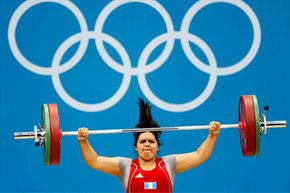If 10-year-old Naomi Kutin wasn't the strongest girl in the world in 2012, then she'd be among the brawniest. That year, at a weightlifting meet in Corpus Christi, Texas, the 99-pound (44.9-kilogram) Kutin deadlifted a staggering 209.4 pounds (94.9 kilograms) and squatted slightly less [source: Zeveloff]. To put that Herculean feat into perspective, the New Jersey elementary schooler successfully squatted around 215 percent of her body weight -- the same body weight percentage a 180-pound (81.6-kilogram) adult man could likely squat [source: Cross Fit].
Her young age aside, Kutin's accomplishment was twice as significant considering her female physiology. Gender differences in athletic performance have narrowed over the past century as more sports have opened up to women and more attention and funding have been directed toward female athletic training through initiatives such as the Title IX law in the United States. But certain fundamental sex differences exist between men's and women's physical prowess. Men's greater upper body strength is a prime example. So while Naomi Kutin may be able to handily out-lift all her male classmates, she's an impressively strong exception to the rule.
Advertisement
Women's lower body strength tends to be more closely matched to men's, while their upper body strength is often just half that of men's upper body strength. In a 1993 study exploring gender differences in muscle makeup, female participants exhibited 52 percent of men's upper body strength, which the researchers partially attributed to their smaller muscles and a higher concentration of fatty tissues in the top half of the female body [source: Miller et al]. Another study published in 1999 similarly found women had 40 percent less upper body skeletal muscle [source: Janssen]. Even controlling for athletic aptitude doesn't tip the upper body strength scales in favor of the female; an experiment comparing the hand grip strength of non-athletic male participants versus elite women athletes still revealed a muscle power disparity in favor of the menfolk [source: Leyk et al].
Acknowledging this gender difference doesn't imply that weight-lifting women can't combat this bit of biological determinism and beef up their biceps; instead, men simply have a head start in that department thanks to their elevated levels of testosterone. The sex hormone has anabolic effects, meaning it promotes muscle development. Secreted by the pituitary gland, testosterone binds to skeletal fiber cells and stimulates the growth of proteins, the building blocks of meaty muscles [source: Roundy]. At the same time, however, testosterone also may shave off men's strength for the long haul.
Advertisement




